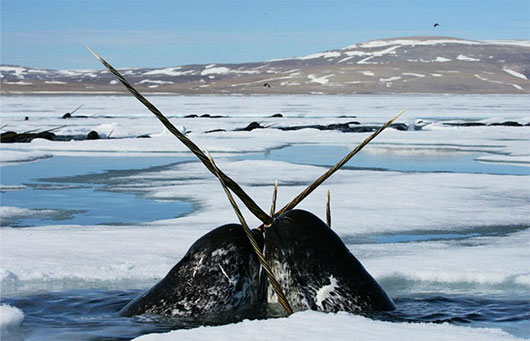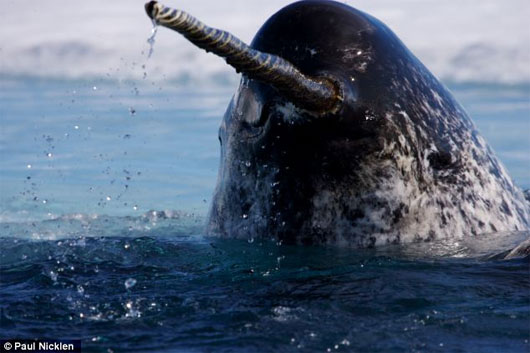Decipher the mysterious ivory of the narwhal
Scientists have finally deciphered the mystery of an abnormally long, spiraling tooth sticking out of the mouth of narwhal, a Arctic whale.
According to the researchers, the abnormally long tooth grows from the upper jaw, the left only exists in the male sea unicorns. These narwhal tusks can grow to a length of 2.6 meters.

Only male narwhals grow spiral teeth, elongated long out of mouth.(Photo: Daily Mail)
When examining the structure, researcher Martin Nweeia of Harvard University School of Dentistry (USA) and colleagues discovered grooves scattered throughout the outer layer of the ivory, allowing seawater to enter the teeth. The outer layer is connected to another layer below, called dentin , which also contains small tubes. These tiny tubes run to the innermost part of the ivory - the medulla, filled with blood vessels and nerves.
Nerves run straight from the roots of unicorn ivory to the brain, helping to enhance the ivory's ability to react to external stimuli.
The team believes that ivory helps male unicorns recognize changes in the environment, facilitate them to find food, detect partners and see if the females are ready to mate. not yet

Pangasius acts as a "biological sensor device" , helping them to recognize the changing environment.(Photo: Daily Mail)
"The new evidence reveals, many different functions of narwhal ivory may have promoted the evolutionary development and durability of the tooth system in this species," cited the report in the journal. The Anatomical Record.
Experts also discovered that when the ivory exposed to different salinity levels of the water, their heart rate also changed accordingly. This once again confirms, narwhal use the ivory's sensing ability to regulate the heart rate to match the salinity of the water environment.
- An unprecedented sight of the sea monster
- Track the narwhal in the Arctic
- Thailand is a country with large illegal trade in ivory
- The hybrid between white whales and narwhal
- Found 3-meter ivory fossils in China
- One person in Gia Lai owned ivory for more than 19,000 years
- African elephants are evolving into ivory because of excessive poaching
- Elephant met with art because of ivory advertising on Google
- Kenya confiscated two tons of ivory
- Thailand will strengthen elephant protection
- Found mammoth ivory in the middle of American streets
- Mexico discovered ivory 10,000 years before BC
 Surprised: Fish that live in the dark ocean still see colors
Surprised: Fish that live in the dark ocean still see colors Japan suddenly caught the creature that caused the earthquake in the legend
Japan suddenly caught the creature that caused the earthquake in the legend A series of gray whale carcasses washed ashore on California's coast
A series of gray whale carcasses washed ashore on California's coast Compare the size of shark species in the world
Compare the size of shark species in the world